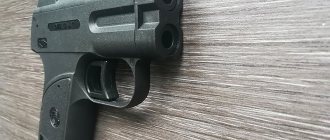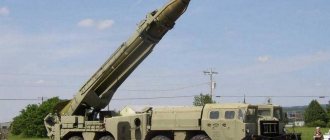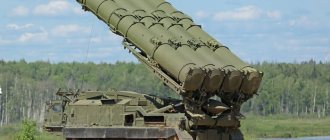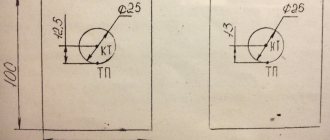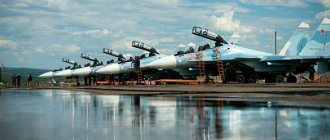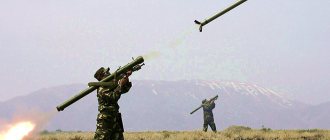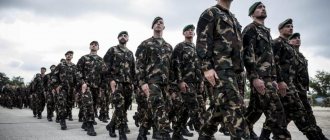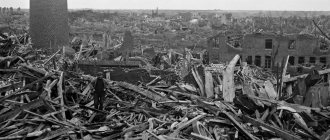Pulling the trigger. Stopping shooting, unloading and inspecting the machine gun after shooting
To release the trigger, you need to firmly hold the machine gun with your left hand by the fore-end or magazine, and with your right hand, pressing the pistol grip to your shoulder, holding your breath, continue to smoothly press the trigger until the trigger, unnoticed by the machine gunner, is released from the cocking position, i.e. e. until the shot is fired. In this case, the index finger is placed first on the trigger. You need to press the hook smoothly and straight back.
Pulling the trigger
If, when aiming, the straight front sight deviates significantly from the aiming point, it is necessary, without increasing or decreasing the pressure on the trigger, to clarify the aiming and again increase the pressure on the trigger until the shot occurs.
When releasing the trigger, you should not attach importance to slight vibrations of the level front sight at the aiming point. The desire to pull the trigger at the moment of best alignment of the straight front sight with the aiming point, as a rule, leads to pulling the trigger and an inaccurate shot.
If the machine gunner, pressing the trigger, feels that he can no longer breathe, it is necessary, without increasing or weakening the finger pressure on the trigger, to resume breathing and, holding it again as you exhale, clarify the aim and continue pressing the trigger.
Holding the machine gun from a prone position from the rest
To fire a machine gun from a rest, place the machine's fore-end on the rest and hold it with your left hand by the magazine or fore-end, and with your right hand by the pistol grip.
To soften the hard stop, cover it with turf, a rolled-up raincoat, a roll of an overcoat, etc.
Stop shooting
The cessation of shooting can be temporary or complete.
To temporarily stop shooting, the command “Stop” is given, and when shooting in motion - “Cease fire”. Following these commands, the machine gunner stops pressing the trigger, puts the machine on safety and, if necessary, changes the magazine.
To completely stop firing, after the command “Stop” or “Cease fire,” the command “Unload” is given.
The position of the machine gun after the ceasefire from a prone position
Executing the “Stand Up” command The machine is prepared for inspection in a standing position
At this command, the machine gunner puts the safety on the machine gun, pulls the clamp back and sets the sight to “P”, and unloads the machine gun.
When shooting from a prone position, holding the machine gun with your right hand by the fore-end and the barrel guard, lower the butt to the ground, and place the muzzle on the forearm of your left hand.
When firing from a trench, after unloading, the machine gun can be placed on the parapet of the trench with the bolt handle downward.
Unloading a weapon
To unload a machine gun: separate the magazine; remove the machine from the safety lock; slowly pull the bolt frame back by the handle, remove the cartridge from the chamber and release the bolt frame; pull the trigger (decock the hammer); put the machine gun on the safety, take it “on the belt” if shooting was carried out from a standing position and from a kneeling position, or put it on the ground if shooting was carried out from a prone position; remove the cartridges from the magazine and attach the magazine to the machine gun; pick up the cartridge removed from the chamber.
To remove cartridges from the magazine, you need to take the magazine in your left hand with the neck up, the supporting protrusion towards you, with your right hand, using the cartridge, moving the cartridges one by one away from you, remove them from the magazine.
To stand up, you need to pull both hands to chest level, holding the machine gun with your right hand by the fore-end and the barrel guard, at the same time bring both legs together, sharply straightening your arms, lift your chest off the ground and bring your right (left) leg forward, quickly stand up and, if we need to start moving.
Inspecting the machine gun after firing
After unloading, if necessary, the commander gives the command “Weapon for inspection.” With this command you need to:
In a prone position: separate the magazine and place it near the machine with the neck facing you.
Remove the safety catch from the machine gun, pull the bolt frame back by the handle and turn the machine gun slightly to the left; After the commander has inspected the chamber and magazine, release the bolt frame forward, release the hammer (press the trigger), put the safety on the machine gun, and attach the magazine to the machine gun.
In a standing position: - holding the machine gun with your left hand from below by the forend, with your right hand separate the magazine and transfer it to your left hand with the feeder up, the convex part away from you, with the fingers of your left hand press the magazine to the forend of the machine gun; - remove the machine from the safety catch, move the bolt frame back and turn the machine slightly to the left.
After the commander has inspected the chamber and magazine, release the bolt frame forward, decock the hammer (press the trigger), put the safety on the machine gun, attach the magazine and take the machine gun to the “belt” position.
Tags: fire training
Weapon readiness positions
The ready positions of the weapon are as described by Jeff Cooper for a pistol with a single action trigger, but this is also true for weapons with a double action trigger:
Position 0: Cartridge in chamber, magazine fully loaded in weapon, hammer cocked, safety off. The position immediately before the shot. There is no point in wearing it in this position, because... An accidental discharge from a blow to the weapon or its fall cannot be ruled out. Position 1: Cartridge in chamber, magazine fully loaded in weapon, hammer cocked, safety engaged. This is the standard position for such weapons to be carried in a holster. An accidental shot is excluded. The advantage of this position: just remove the safety and you can shoot. Minus: over time, the mainspring shrinks and needs to be replaced. Position 2: Cartridge in chamber, magazine fully loaded in weapon, hammer pulled. In this position, the weapon can be carried in a holster, bag, etc. An accidental shot is excluded. Disadvantage of this position: You must cock the hammer to fire. Plus: no spring in the weapon shrinks. Position 3: Chamber empty, fully loaded magazine in weapon, hammer pulled. In this position, the weapon is safe, an accidental shot is excluded, but bringing it into the firing position does not take too long, although much longer than from Position 1 . The disadvantage of this position: to fire, you need to send the cartridge into the chamber by jerking the bolt. Plus: no spring in the weapon shrinks, the position is almost absolutely safe. Position 4: The chamber is empty, there is no magazine in the weapon, the trigger is pulled. In this position, the weapon is absolutely safe, an accidental shot is excluded. The disadvantage of this position: to fire, you need to insert the magazine into the handle of the weapon, then send the cartridge into the chamber by jerking the bolt. Plus: absolutely safe position. It is there that the law requires the transportation of weapons.
As for the readiness positions in practical and defensive pistol shooting at the beginning of the exercise, there are only 3 of them.
For pistols with a single action trigger: Fully loaded - cartridge in chamber, loaded magazine in weapon, hammer cocked, safety off. Previously called "Position 1". Loaded – chamber empty, loaded magazine in weapon, hammer deactivated. Previously called "Regulation 2". Unloaded – the chamber is empty, the magazine is missing, the trigger is deactivated. Previously called "Regulation 3".
For pistols with a double-action trigger: Fully loaded - cartridge in chamber, loaded magazine in weapon, hammer deactivated. Previously called "Position 1". Loaded – chamber empty, loaded magazine in weapon, hammer deactivated. Previously called "Regulation 2". Unloaded – the chamber is empty, the magazine is missing, the trigger is deactivated. Previously called "Regulation 3".
4.2. Types of positioning for pistol shooting
4.2. Types of positioning for pistol shooting
Shooting while standing “with one hand”
Studies of cases of use and use of weapons by police officers indicate that in 59.9% of cases, police officers shoot while standing. Moreover, in 75.4% of cases, shooting from a pistol is carried out from a standing position “with one hand”, however, when shooting at high speed in a limited time (and according to the study, in 88.7% of cases the time for shooting was limited) it is most preferable holding a pistol with both hands[19]. However, in the event of sudden oncoming fire from the offender, the police officer can take a standing shooting position with “one hand.”
Shooting from a standing position is more difficult than from a prone or kneeling position due to the unstable position of the shooter’s body. Insufficient stability of the position in this position is due to the high location of the general center of gravity of the “shooter’s body - weapon” system above the support area, the small size of the support area (limited by the feet), a more tense muscular system, which is caused by fixing the moving parts of the body and holding it in a vertical position .
The “one-handed” shooting method is practiced in a classic (or sports) position.
In pistol shooting, the following options are distinguished:
- half turn;
- sideways to the target.
The most optimal position for shooting is a standing position “with one hand” (Fig. 110): the shooter is positioned half-turned or with his right side to the target, with his feet shoulder-width apart (feet slightly apart). The right hand with the weapon is fully straightened at the elbow joint and directed towards the target. This allows you to maintain a constant distance between the shooter’s eye and the sighting device, which creates conditions for uniform aiming, and the forearm and shoulder are more rigidly fixed to each other, which helps reduce weapon vibration.
Rice. 110. Standing shooting position “one-handed”
The head is turned to the right side, without tilting down or leaning back, its position should be natural (without straining the neck muscles), the cheek touches the shoulder of the right hand, creating the feeling of a butt attached to the handle of a pistol. The left hand is relaxed; it can be placed in the trouser pocket, hooked with the thumb of the free hand onto the belt, or pressed against the thigh (Fig. 110). The body weight of the shooter with the weapon should be evenly distributed on both legs or a little more on the leg standing behind and slightly closer to the toes (Fig. 111). This promotes equal muscle sensitivity in each leg.
For optimal preparation, it is necessary to move the pelvis slightly to the right - forward, and tilt the torso to the left - back, i.e. balance the weight of the body and weapon with the arm extended to the right (Fig. 110). In this case, there should be no excessive tension in the muscles of the torso and arms. The line through the shoulders (Fig. 111) should be parallel to the line through the feet.
It is not recommended to twist the body around the longitudinal axis, because at the moment the trigger is pulled, when the shooter’s attention is directed to processing the shot, the muscles of the body, against his will, will take their natural position and the weapon will “go away” to the side.
Fig. 111. Setting up for shooting “one-handed” (top view):
1 - center of gravity; 2 - line of the hand with the weapon: 3 - line of the shoulders: 4 - angle between the line of the shoulders and the line of the hand with the weapon.
Checking the correctness of the adopted preparation in relation to the goal
is carried out according to the same principle as when shooting from a rifle. To check the correctness of the preparation, you need to carefully aim, close your eyes, relax your muscles, and then close your eyes and look where the weapon is pointed. If the barrel of the weapon is directed somewhere away from the target, to the right or left of it, it is necessary, without changing the position, to change the direction of the barrel, but not by moving the hand holding the pistol, but by turning the entire body in relation to the target, rearranging the feet.
Before shooting, you should check the correctness of your grip, mainly in relation to the position and operation of the index finger and the degree of tightness of the grip. If the weapon also moves along with the movement of the index finger, then you should check the position of the index finger, generally reconsider the grip and change it slightly.
When training to shoot “one-handed,” you develop a “shooter-weapon” balance, as well as a feeling of overall confident stability necessary for all types of shooting.
Shooting "kneeling" and "sitting"
The “kneeling” shooting position is adopted when the shooter, who is in the “standing” shooting position, needs to reduce the shooter’s engagement area without changing the direction of fire.
When holding a weapon with one hand, the position for shooting “from the knee” is assumed as follows: simultaneously with the beginning of actions to remove the weapon from the holster, the shooter takes a step with his right foot towards the target, while lowering himself on his left knee, sits with his buttock on the heel of his left foot, placed vertically to the ground (Fig. 112). The angle of inclination of the right leg shin is selected taking into account the characteristics of the shooter’s body.
In order to find a rational position for shooting from the knee (Fig. 112), it is necessary: to distribute the weight of the shooter’s body onto the support points of the body surfaces - the foot of the right foot and the toe of the left foot. The left hand should rest on the shin of the left leg. Stability of the position can be achieved if the weight load falls unevenly on each of the three supporting surfaces of the body, and to the greatest extent on the heel of the left foot.
Rice. 112. Kneeling position
In order to shoot while sitting, the shooter squats, shifts his body weight back and, putting his non-working arm back and leaning on it, sits on his buttocks. You can lean on your palm or elbow.
Rice. 113. Shooting position “sitting” with support on the palm or elbow
When shooting while sitting “with one hand,” the legs remain bent (the right knee serves as a support for the hand with the weapon) or extended forward, and the non-working hand is behind and serves as a support (Fig. 113).
One-handed prone shooting
The prone shooting position (Fig. 114) is more stable compared to the standing shooting position, which is explained by the larger support area of the shooter’s body and the lower height of his center of gravity.
The main requirement for manufacturing is to ensure good stability of the weapon due to the least muscle tension and a natural position of the head, which creates normal conditions for the eye to work while aiming.
Rice. 114. Prone shooting positions “one-handed”
To assume a prone shooting position with one hand, the shooter must:
- take a full step with your right foot forward and to the right, leaning forward, and lower yourself onto your left knee;
- unfasten the holster, remove the pistol, place your left hand on the ground in front of you, palm to the right. then, leaning successively on the thigh of the left leg and the forearm of the left hand, lie on your left side;
- turn off the safety with the thumb of your right hand and pull the bolt back, sending the cartridge into the chamber;
- quickly turn onto your stomach, spread your legs slightly to the sides with your toes outward, point the weapon at the target, holding the raised torso with your left hand bent at the elbow, which rests with your forearm on the ground.
Shooting standing "two hands"
A large number of shooting errors arise from incorrectly holding the pistol, incorrect hand position and incorrect stance. Currently, pistol shooting has developed the most convenient positions for shooting “with two hands” (double grip), allowing you to make accurate aimed shots in static positions and at the same time easily hit targets in motion.
Pistol shooting training should be carried out observing one of the pedagogical principles of training - from simple to complex. Anyone who picks up a combat pistol for the first time is recommended to begin training by shooting in the simplest and most reliable way, namely holding the pistol with both hands. When shooting “with both hands,” the weapon has great stability, which allows beginners to fully master the elements of pistol shooting technique.
In world shooting practice, when shooting “two-handed” the following are most often used: Weaver stance; shooting in a triangle (“Israeli”)[20]
. The main difference between them was the location of the body of the middle relative to the line of fire.
In the “triangle” position (Fig. 115), the shooter stands facing the target perpendicular to the shooting line, the body is slightly tilted back to ensure the balance of the shooter-weapon system. To reduce the load on the back muscles, the shooter should slouch slightly. The feet are placed approximately 15 cm wider than the shoulders, the left leg is extended 3-5 cm towards the target, the feet are parallel to each other or slightly turned out, the legs are fully straightened (or slightly bent at the knees) to stabilize the ankle joint and reduce the shooter's body sway forward and back. The arms holding the gun should be straight. To fix the rigidity in the triangle position, the force of the shooting hand is directed “away from you”, the force of the supporting hand is directed “towards you”.
Rice. 115. Shooting in a triangle position
Rice. 116. Making a “triangle” top view
The triangle formed by outstretched arms and shoulder width does not have to be symmetrical. Depending on the way you grip the pistol, your left hand may be pushed forward, and your right shoulder, of course, may be pulled back.
When shooting “with both hands” in a universal position (Weaver stance) (Fig. 117), the shooter is positioned at an angle to the line of fire. Feet shoulder-width apart, right leg set back, left shoulder pointing forward. The head is set straight.
The arm holding the weapon is straightened (or bent at the elbow joint) with a push-pull force, the supporting arm is bent (or straight), with a push-pull force. Body weight is evenly distributed on both legs. The center of gravity should be shifted to the toes of the feet.
The body is slightly tilted forward, which allows for better control of the pistol during high-speed shooting. If you stand straight, then after each shot the body will lean back, and in order to fire the next shot, you will need to return to its original position. At the same time, you should not lean forward too much; this hampers the shooter and increases the time it takes to transfer the weapon from one target to another.
In this stance, the shooter is presented with a smaller target, and to assume a kneeling shooting position, simply kneel down on the right leg.
Mastery of this position can be carried out according to the proposed scheme: the student stands in a frontal stance with a weapon in his right hand. makes a turn with his left side towards the target at 35–45° and raises his straight arm with the weapon to waist level towards the target. In this position, the left hand is placed on the weapon, which is bent exactly as much as the position of the right hand allows.
Rice. 117. Universal production
The index fingers of both hands should be in the same plane, the thumb of the left hand overlaps the thumb of the right hand, after which the weapon is raised to eye level.
The cheek touches the shoulder of the right hand, creating the feeling of a butt attached to the handle of a pistol.
A stable position of the gun in space is achieved by the presence of two forces. One force is the right hand, which pushes the gun forward, the second force is the left hand, which pulls the gun back. Strong tension in the arm muscles should be avoided, achieving a balance of power in which the shooter can stand in the stance for a long time without tension.
A prerequisite for accurate and accurate shooting with such a preparation is the constancy of the force applied to the weapon before, during and after the shot.
Kneeling and sitting shooting positions
The “kneeling” shooting position is adopted when the police officer, who is in the “standing” shooting position, needs to reduce the shooter’s engagement area without changing the direction of fire and when it is necessary to increase the stability of the weapon by using the support of the armed hand.
When shooting from the knee “with two hands”, there are several ways to prepare for shooting:
- “rifle” position from the knee, with the left hand resting on the knee (Fig. 119).
standing position without resting your left hand on your knee;
- position “from the knees” with emphasis on both knees, sitting on the heels pushed together with support on them (Fig. 121a) and without support (Fig. 121b).
The position for the shooter when shooting from the knee is unnatural compared to the prone or standing position. In this regard, taking into account the structural features of his body, each shooter must select a shooting position in which his muscular efforts to prepare will have a minimal impact on the shooting result.
The stability of the position depends primarily on the correct relative position of the supporting surfaces of the body - the foot of the left leg, the knee and toe of the right leg, which limit the area of support of the body. The most convenient and at the same time quite stable position is one in which the supporting surfaces of the case create a support area in the form of a triangle, formed and limited by the arrangement of the legs in which the right leg makes an angle of 55?65° with the shooting plane.
Rice. 118. The relative position of the supporting surfaces of the body, limiting the area of support when positioned for shooting “from the knee”
Rice. 119. Kneeling position
In this case, the left leg should be brought forward within half a step and bent at the knee joint so that the shin is approximately in a vertical position, and the foot of the left leg should be placed at an angle of 35–55′ to the shooting plane. With this turn of the foot to the right, the ankle joint is better secured, which contributes to better stability of the left leg as a whole (Fig. 118).
To assume a kneeling shooting position, the student:
— holding the barrel of the pistol towards the target, takes a step back with his right foot;
- places the right knee on the ground opposite the foot of the left leg, sits on the heel (Fig. 119) so that the heel is between the buttocks (or the foot bends inward and the shooter sits on it with the right buttock);
- the left hand is held suspended or bent at the elbow and rests on the knee near the patella and supports the right hand holding the weapon. Your head should be kept straight, without tilting forward. In order for the position of the head to be uniform when aiming, it is necessary to touch the forearm with the cheek (or chin).
Rice. 120. Shifting fire to the right - back
The above-described position for shooting from the knee is maneuverable and allows you to transfer fire to the right - back (Fig. 120).
If a threat arises from behind, the shooter, who is in the “kneeling” position when shooting, without lifting his feet from the ground, turns his body to the right - the right knee rises and the left knee drops slightly. The shooter finds himself (Fig. 120b) in a semi-squat position (the so-called low spatial position).
Next, a clockwise turn is made - the left knee is lowered to the ground, and the right knee is raised vertically. Then you need to place the elbow of the hand with the weapon on your right knee and fire, so the shooter turns 180′ towards the target that appeared from behind (but you can fire without resting your right hand on your knee (Fig. 120c). You need to learn how to make this turn with one movement.
A
B
Rice. 121. Kneeling shooting position
When shooting while sitting “with both hands”: the shooter sits on his buttocks, legs bent at the knees, feet on the ground. The elbows of the bent arms rest on the knees (Fig. 122a). An option is possible when the shooter tilts his torso forward and tucks his legs “Turkish style”. The pistol is held with both hands, sometimes with support on the knees or thighs (Fig. 122b).
A
B
Rice. 122. Position for shooting while sitting “with two hands”
Two-handed prone shooting position
The prone shooting position is assumed as follows:
- Leaning forward, take a full step forward with your left foot, lower yourself to your right knee:
- unfasten the holster, remove the pistol, place your left hand on the ground in front of you, palm to the right, then, leaning successively on the thigh of your left leg and the forearm of your left hand, lie on your left side;
- turn off the safety with the thumb of your right hand and pull the bolt back, sending the cartridge into the chamber;
- quickly turn onto your stomach and rest the elbows of both hands on the ground;
— the hand supports the pistol under the magazine or under the trigger guard;
- legs should be spread wider than the body, feet parallel to the ground.
Rice. 123. Position for firing a pistol “with two hands”:
a - lying on your stomach; b - lying on your back: c - lying on your side.
In the event of a threat from behind, the shooter, who is in the “lying on his stomach” shooting position, can move to the “lying on his side” shooting position (Fig. 123c) and shoot to the side. By moving to the side with a roll and turning over on your back (Fig. 123b), you can shoot backwards. From this position you can sit down and fire while sitting, and at the end with a sharp jerk you can get to your feet. The above combination for shooting with two hands is one of the simplest.
The use of one or another product depends on the current situation. It must be remembered that in a firefight you need to constantly move, moving from one stance to another, in different directions and pace.


